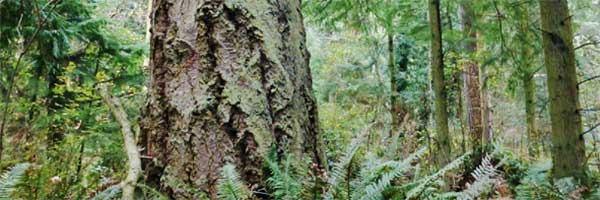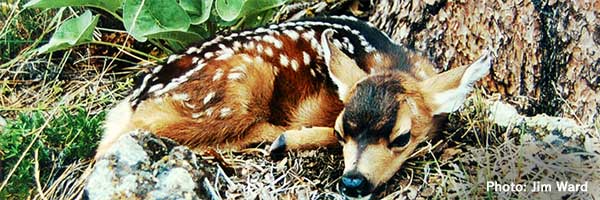Specific Habitats of Oregon
 |
WESTSIDE HABITATS |
 |
EASTSIDE HABITATS |
 |
OAK HABITATS |
 |
HABITAT TOOLS |
Westside Habitats
The following resources focus on westside habitats:
|
Westside Douglas-fir Forests and Wildlife Oregon’s westside Douglas-fir forests are one of the most productive and economically important forest types in the world, and are common in the state. These forests also provide habitat for a wide range of wildlife species. This resource discusses management tools for family forest owners. |
|
Coastal Douglas-fir Forests and Wildlife In coastal Douglas-fir forests, diverse habitats can be enhanced by using silviculture systems that let you manage both forest resources and wildlife. These systems can provide landowners with financial return while also protecting wildlife. |
|
Riparian Areas: Fish and Wildlife Havens If your property includes water such as a pond or stream, part of your land is riparian. This publication tells how riparian areas provide essential fish and wildlife habitat, and how land use can affect this habitat, and briefly describes management practices that protect or enhance habitat. |
|
Wetlands as Varied as Our Region This bulletin provides some basic information about wetlands and identifies management techniques that protect the functions and values of these lands. |
|
Wildlife in Broadleaf Woodlands of Oregon and Washington Wildlife species live in all types of habitat. Of all the habitats in Oregon, perhaps the most wildlife-friendly is the broadleaf woodland. Today, large tracts of pure broadleaf woodlands exist in very few places. This bulletin provides more information. |
Eastside Habitats
The following resources focus on eastside habitats:
|
Wildlife-friendly Fuels Reduction in Dry Forests of the Pacific Northwest Reducing fuels, improving forest health and enhancing wildlife habitat are common management goals on private dry forests. These goals don’t have to contradict each other, if you follow some simple guidelines. This publication will give you tips and ideas on how to make sure you can meet all your goals. |
|
Managing Ponderosa Pine Woodlands for Fish and Wildlife Proper management practices for ponderosa pine woodlands can help maintain or create fish and wildlife habitat, and also provide a continuing supply of wood products. This publication provides information on how to manage your ponderosa pine stand to improve wildlife habitat. |
|
Fire! The very word elicits powerful emotions of dread and even flight. While fire is a natural phenomenon, it can produce significant changes to forest conditions, with profound emotional shock for woodland owners. However, your land can provide renewed wildlife habitat and biodiversity, and regenerate a new forest rapidly – especially with strategic, well-timed help. There are many resources available to you as you move forward. |
|
Managing Western Juniper for Wildlife Western juniper can provide valuable habitat for many wildlife species. However, too many trees cause the loss of important understory plant species, a loss that can degrade wildlife habitat. When managing juniper woodlands for wildlife, it’s important to maintain a balance of plant layers, including wildflowers, grasses, shrubs and trees. This publication provides information on managing western juniper woodlands to improve habitat for a maximum number of wildlife species. |
|
Riparian Areas: Fish and Wildlife Havens If your property includes water such as a pond or stream, part of your land is riparian. This publication tells how riparian areas provide essential fish and wildlife habitat, and how land use can affect this habitat, and briefly describes management practices that protect or enhance habitat. |
|
Wetlands as Varied as Our Region This bulletin provides some basic information about wetlands, and identifies management techniques that protect the functions and values of these lands. |
Oak Habitats
The following resource focuses on oak habitat:
|
The graceful, spreading Oregon white oak presides over many rich landscapes of the Pacific Northwest and anchors many rich native habitats. This species provides habitat for more than 200 wildlife species, including insects, birds, small mammals, reptiles and amphibians. Due to their ability to survive drought and fire, plus their long-lived nature, a mature oak tree can live up to 500 years while supporting a multitude of species. Read the article to learn more. |
Habitat Tools
The following publications and resources provide guidance on actions landowners can take to intentially manage wildlife habitat:
|
Techniques and Tools for Monitoring Wildlife on Small Woodlands Monitoring wildlife can provide many unique insights into the health and productivity of forestland. This publication offers ideas and tools to help. |
|
Enhancing Wildlife on Private Woodlands Whether you manage land for game, nongame or pest species, the objective is to increase, decrease or maintain numbers of wildlife. This publication discusses techniques for wildlife enhancement. |
|
Grass Seeding Forest Roads, Skid Trails and Landings in the Inland Northwest Sediments are one of the main nonpoint sources of pollution for lakes, rivers and streams in the inland Northwest. This publication shares strategies for protecting waters by seeding forest roads, skid trails and landings. Tables specify ideal mixes of plants best suited for overstory, understory and legumes, so the environment is protected while wildlife and livestock find nourishment. |
|
The Wildlife Garden: Build Nest Boxes for Wild Birds Nest boxes are a great way to attract wild birds to your yard. They provide birds shelter and a place to raise their young. Birds that use nest boxes include chickadees, wrens, bluebirds, swallows, wood ducks and owls. This publication includes plans to build your own nest boxes. |
|
This field guide describes in detail the steps woodland landowners can take to build a large pond on their properties. The guide describes planning, permitting and construction of a pond, and includes sections on maintaining and repairing woodland ponds. It also describes the aesthetic values and benefits to wildlife that woodland ponds provide. |
|
Oregon Forest BioDiversity Explorer The Oregon Forest BioDiversity Explorer provides data on species occurrences and/or modeled distributions for Oregon's important forest species and habitats. |
|
The Oregon Conservation Strategy, developed by the Oregon Department of Fish and Wildlife (website), is an overarching plan to conserve Oregon’s fish and wildlife and their habitats. It combines the best available science and conservation priorities with recommended voluntary actions and tools for all Oregonians to define their own conservation goals. |



